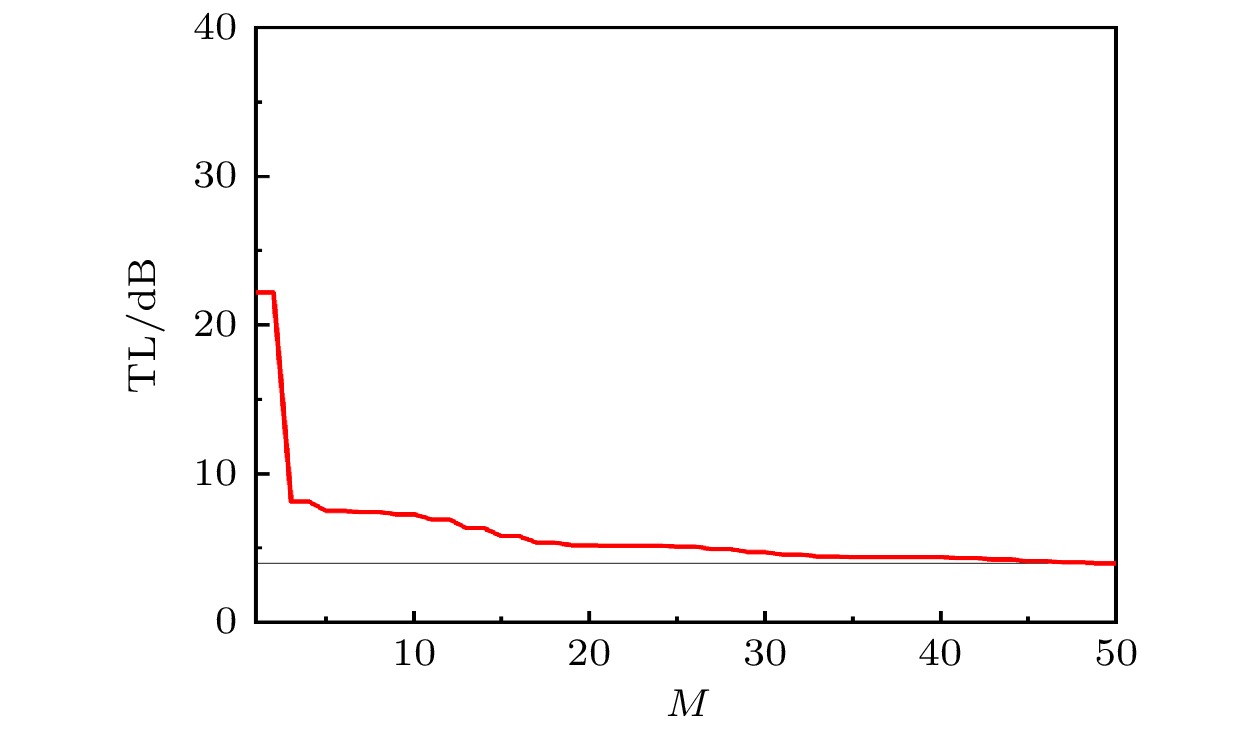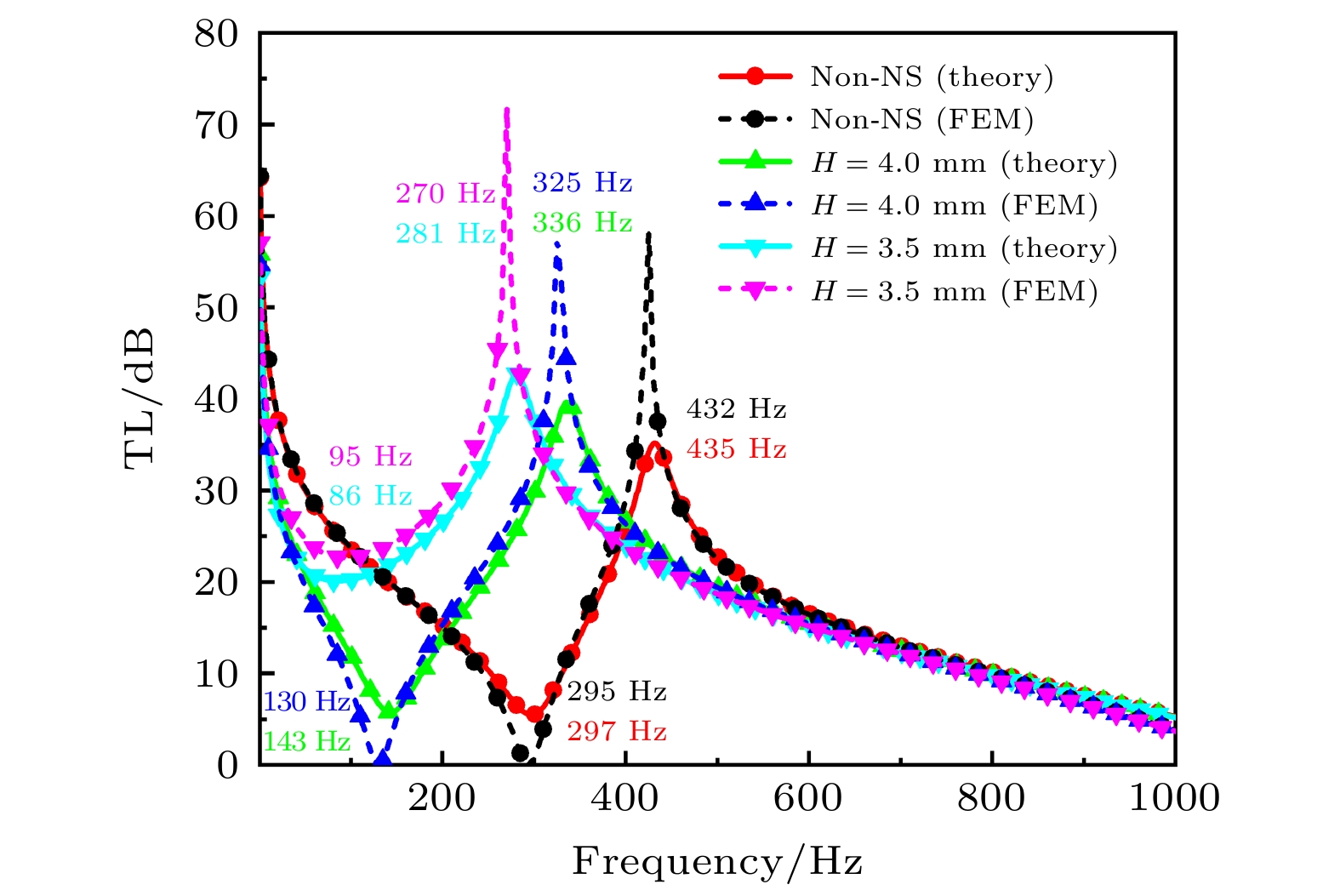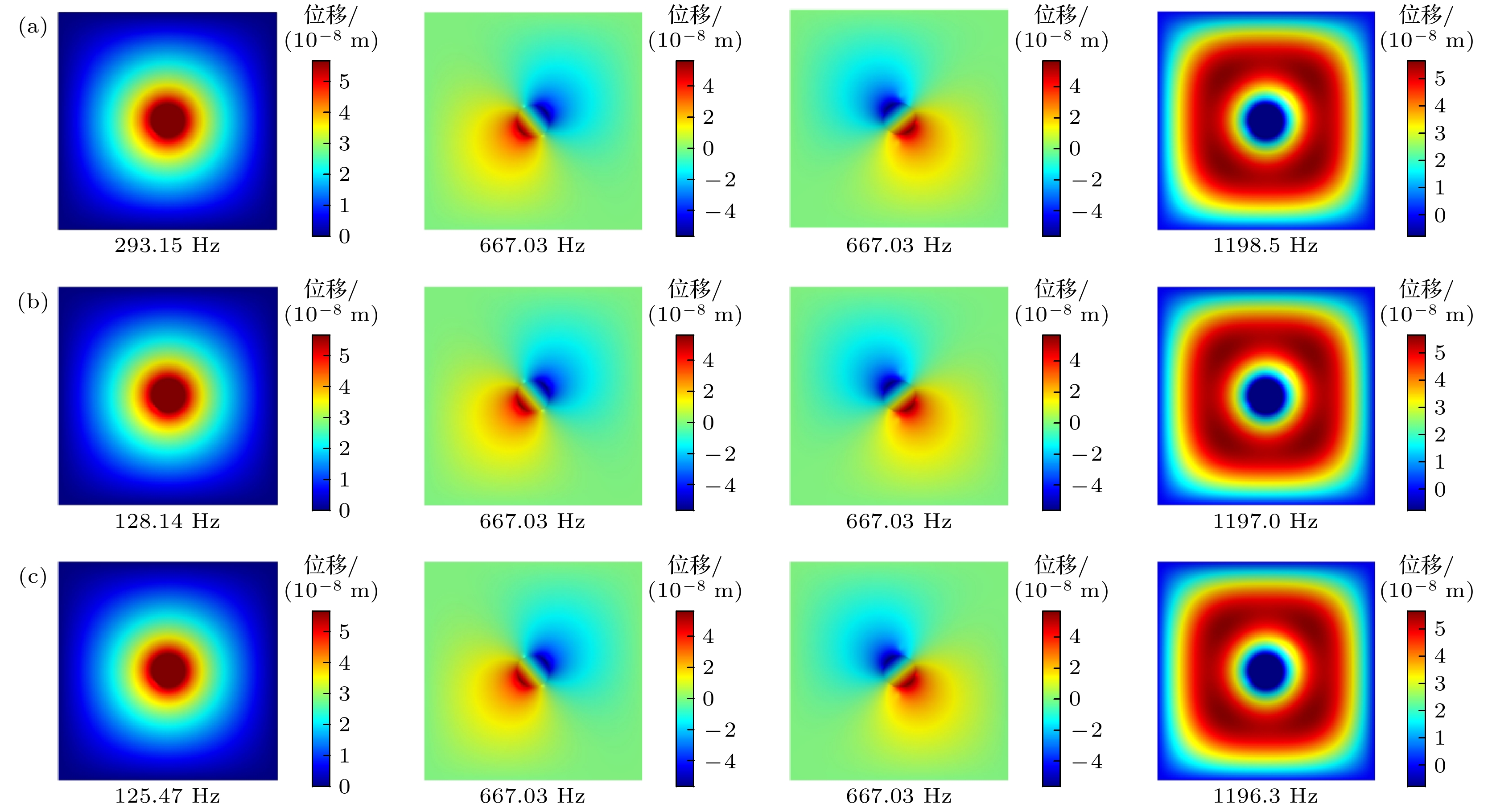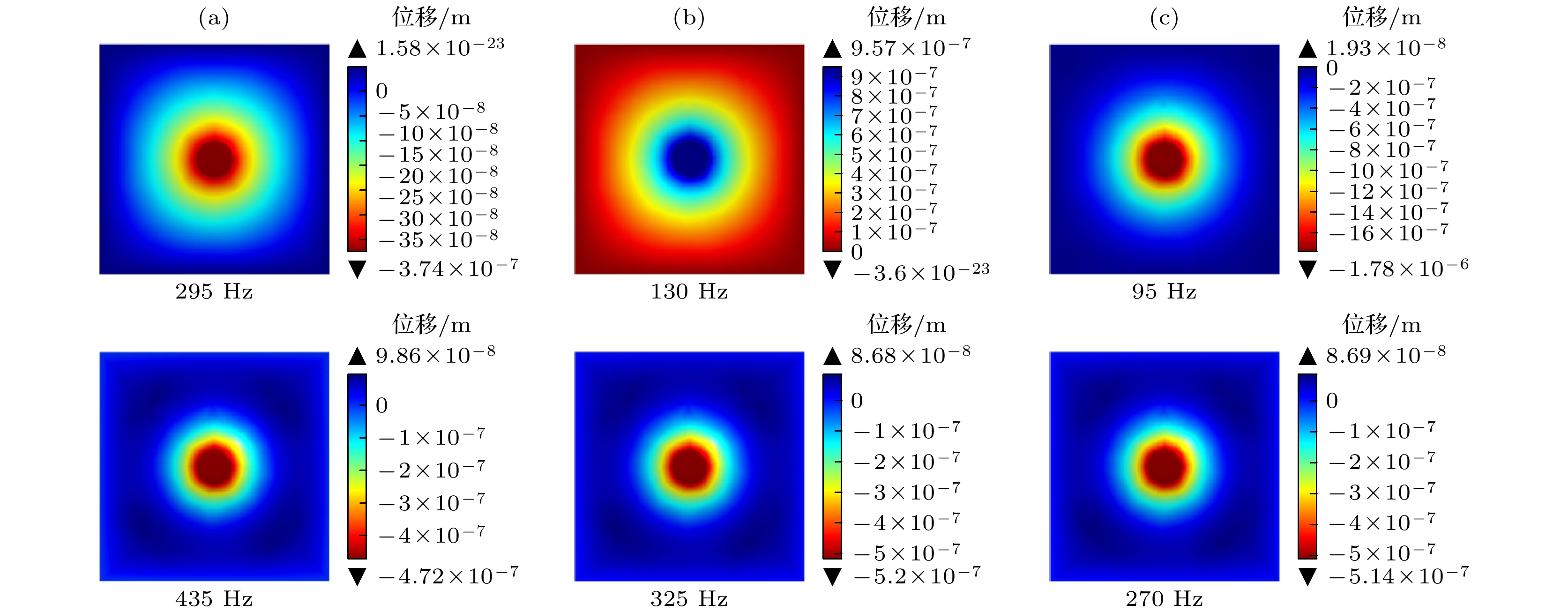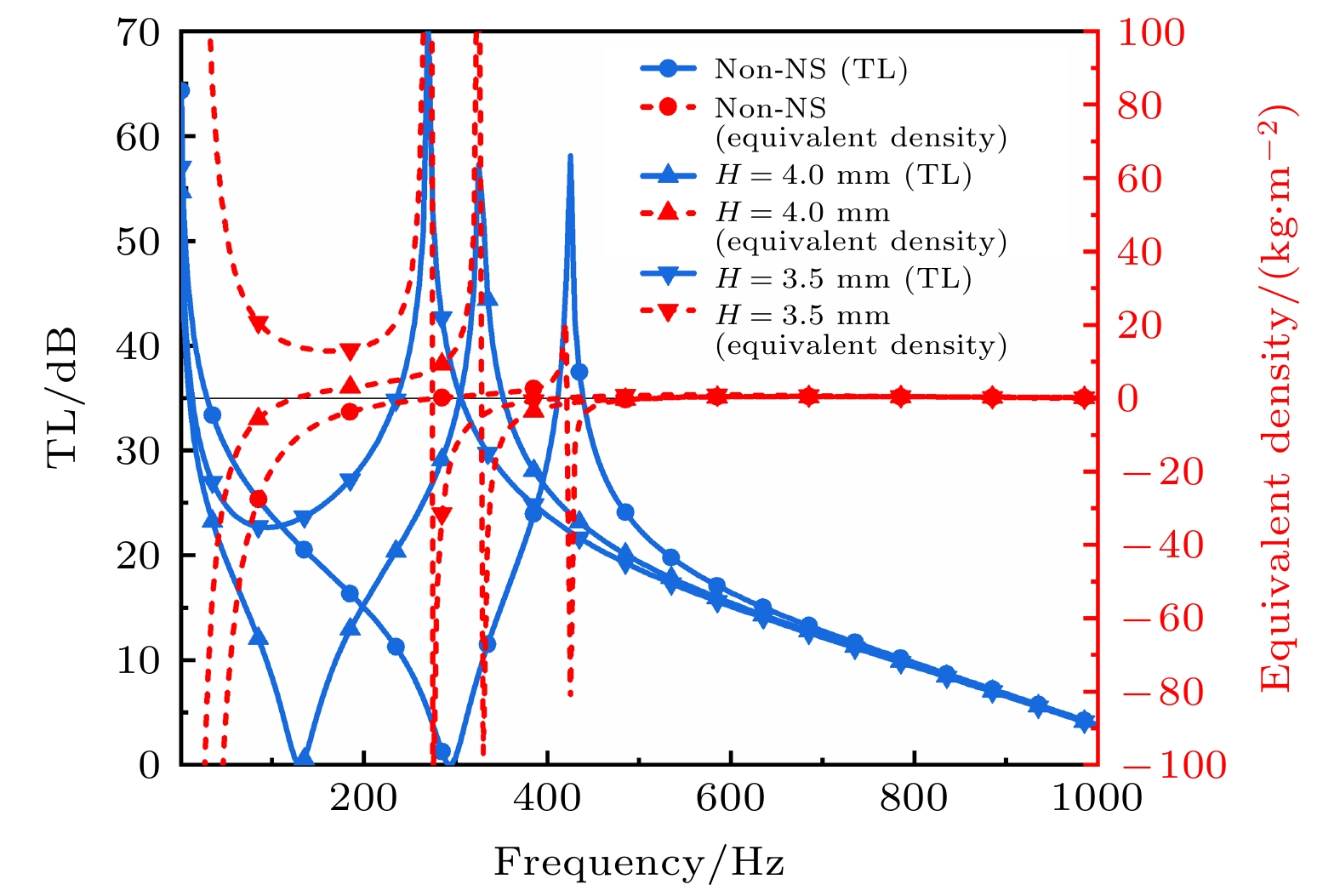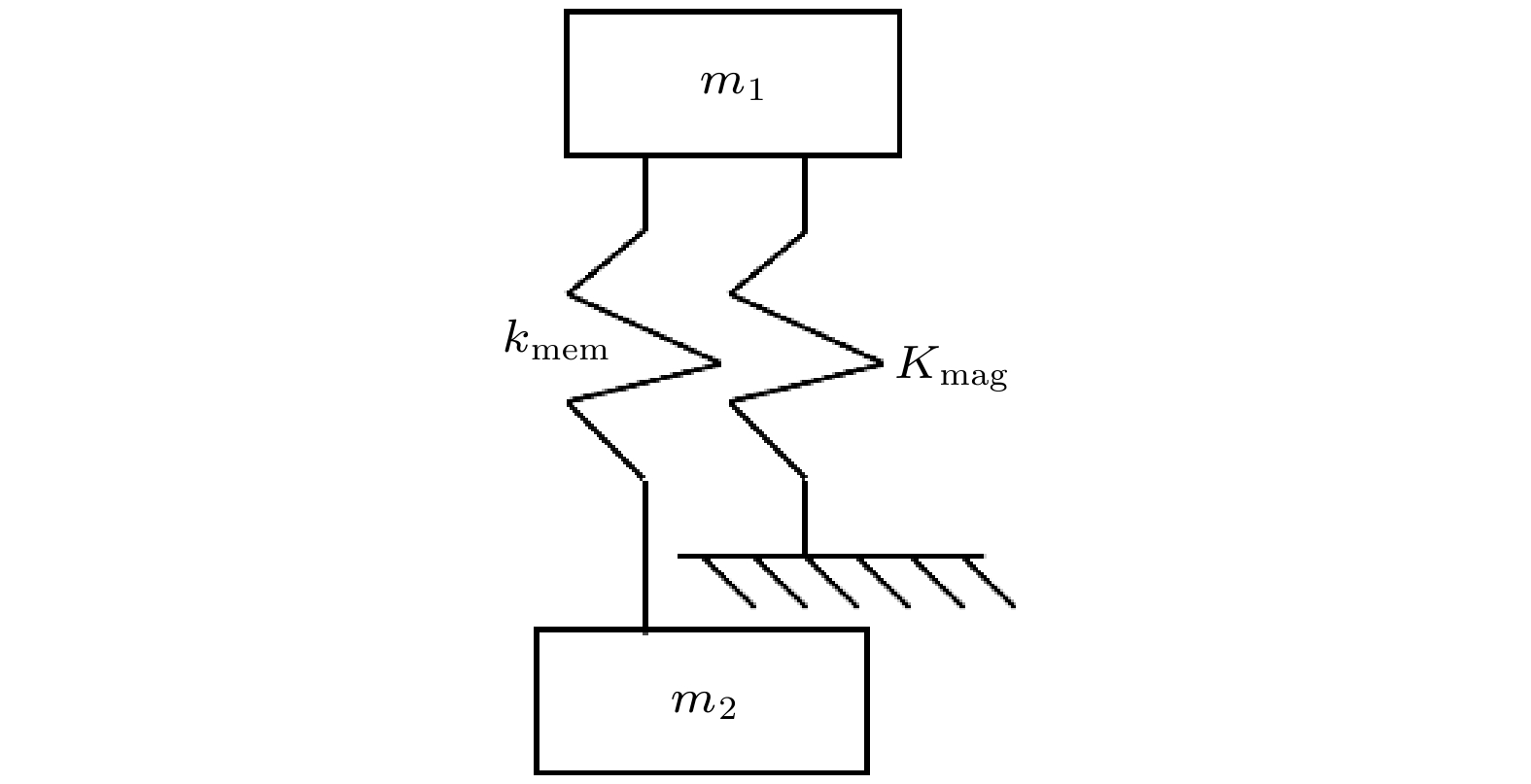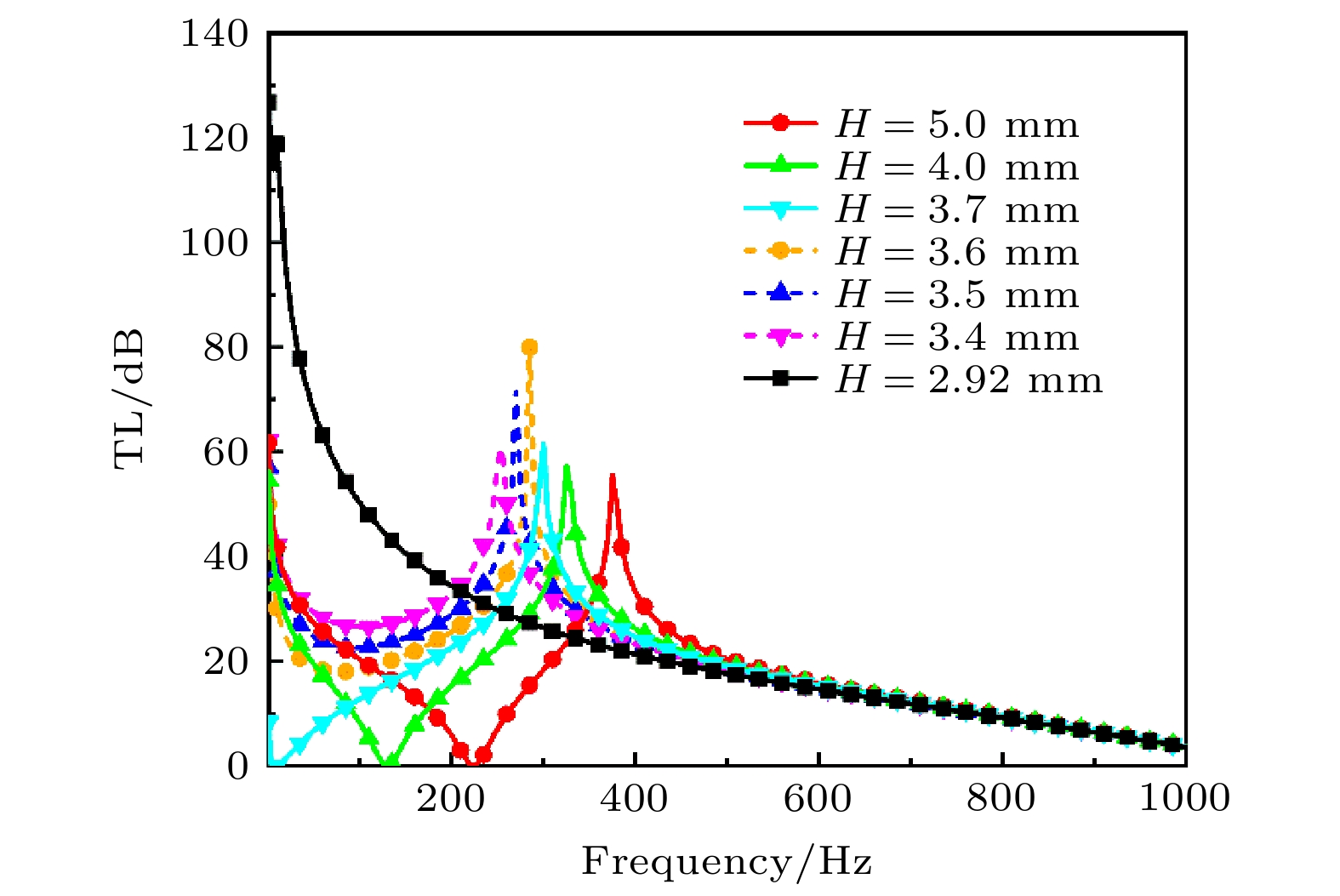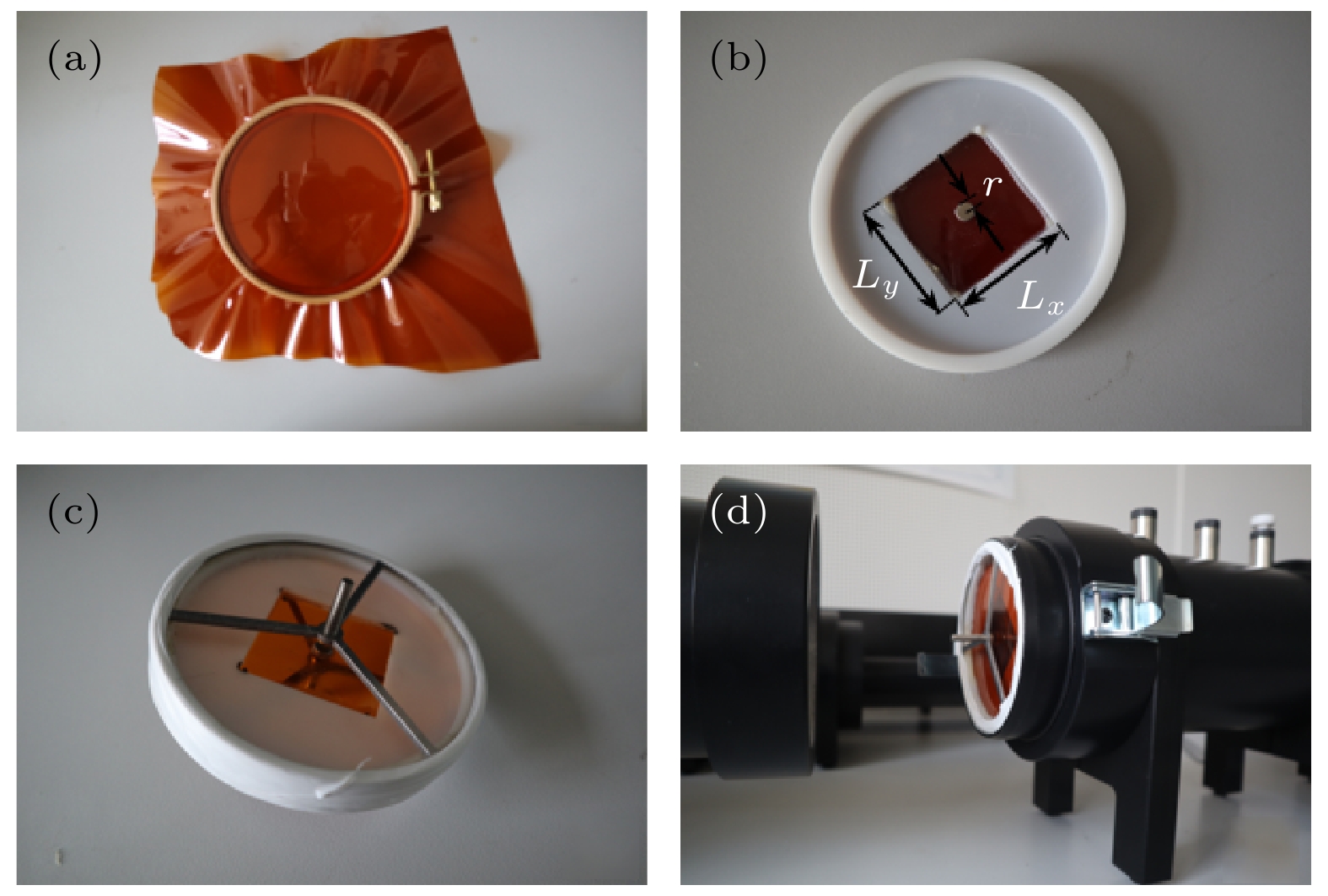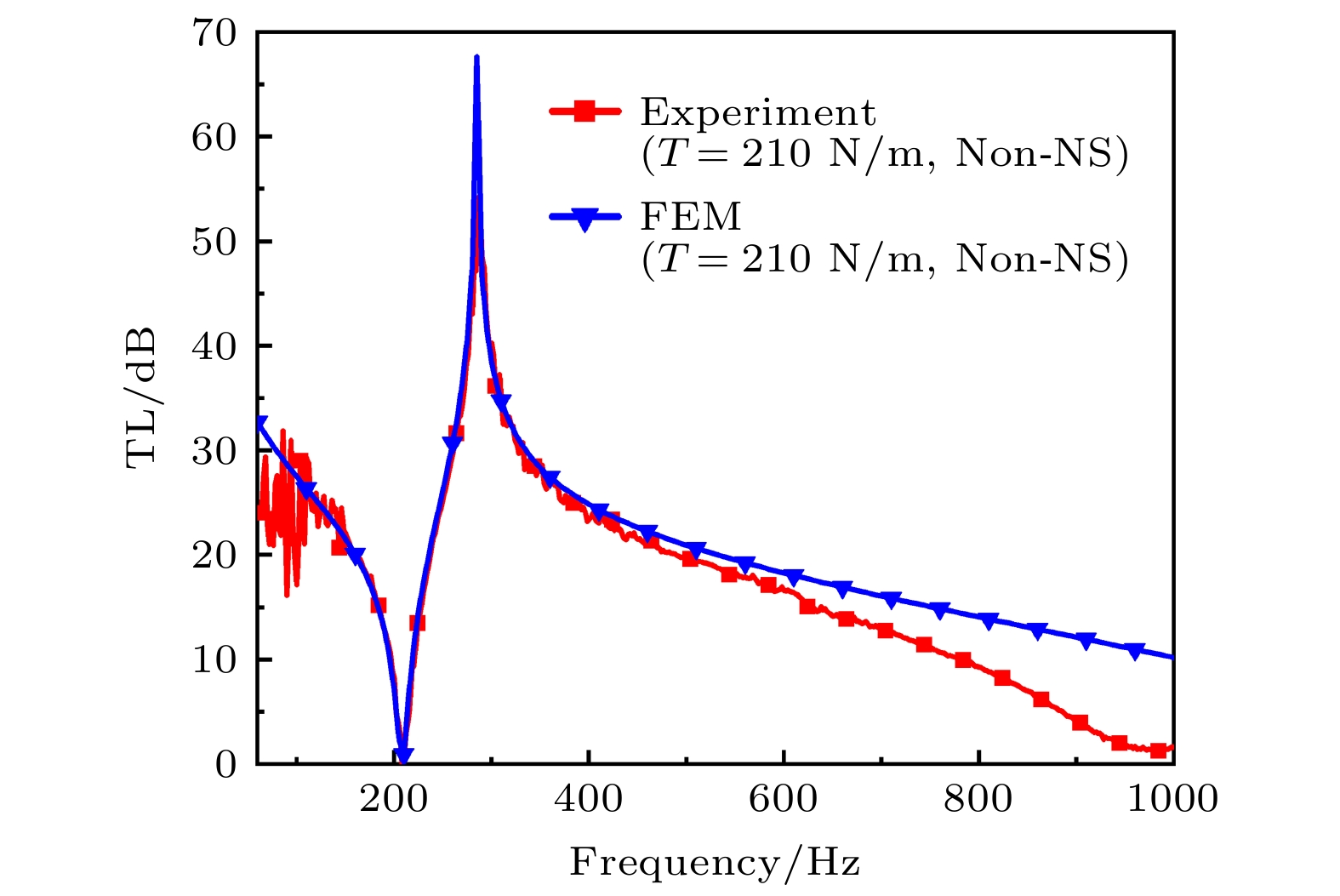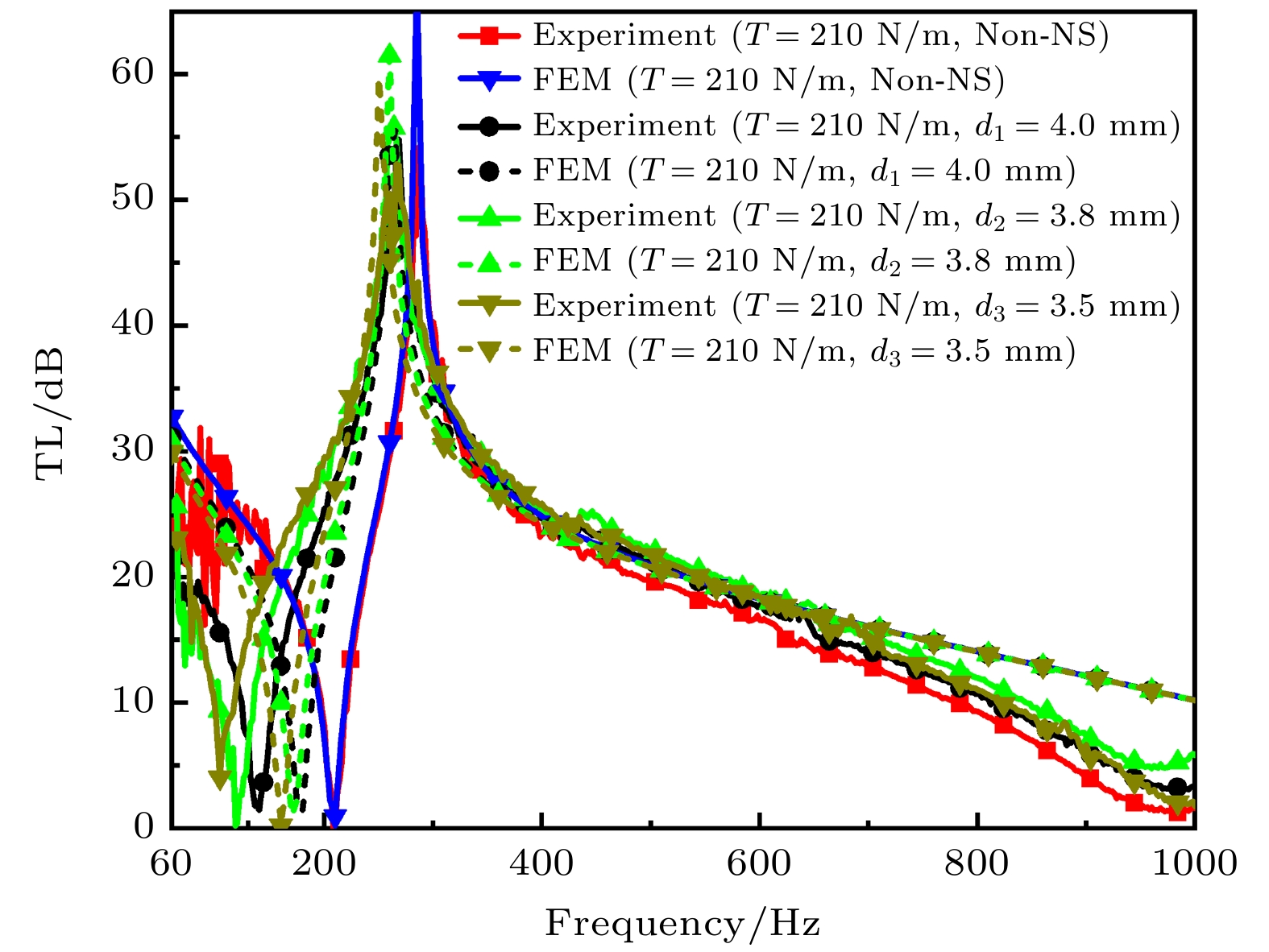-
为提升薄膜/板状结构的低频隔声特性, 本文提出一种具有动态磁负刚度的新型准零刚度薄膜声学超材料. 首先, 应用等效磁荷理论推导了动态磁负刚度; 然后, 基于伽辽金法建立了有限尺寸下薄膜/板结构的隔声理论模型. 通过理论分析、数值仿真及实验测试相结合的方法, 从结构模态、振动模式、平均速度、相位曲线、等效质量密度和等效弹簧-质量动力学模型等多个角度对其低频(1—1000 Hz)隔声机理开展了研究. 结果表明: 在初始薄膜张力一定时, 减小磁间隙或增大剩余磁通密度均可增大动态磁负刚度, 进而减小隔声峰值频率, 增加隔声带宽, 实现了较宽频段下的有效低频隔声; 进一步, 当磁间隙大于第二临界磁间隙小于第一临界磁间隙时, 结构的一阶模态共振消失, 对应隔声谷值大幅提升, 显示出超宽频段的隔声效果. 这种利用动态磁负刚度改善模态共振导致的低频隔声谷值的方法对薄膜/板型低频隔声超材料的设计具有重要的理论指导价值.For improving the low-frequency sound insulation properties of membrane/plate structures, a new quasi-zero stiffness membrane acoustic metamaterial with dynamic magnetic negative stiffness is proposed. When the equivalent magnetic charge theory is used to investigate the dynamic magnetic negative stiffness, a theoretical model of proposed metamaterial with finite dimension is established based on the Galerkin method. Through a combination of theoretical analysis, numerical simulation and experimental measurement, the low-frequency (1–1000 Hz) sound insulation performance of the metamaterial is investigated from several perspectives, including structural modality, vibration mode, average velocity, phase curve, equivalent mass density, and equivalent spring-mass dynamics model. The results show that at a certain initial membrane tension, the decreasing of the magnetic gap or the increasing of the residual flux density can increase the dynamic magnetic negative stiffness. This in turn leads the peak frequency to decrease and the bandwidth of sound insulation to increase, thus achieving effective low-frequency sound insulation over a wide frequency band. Further, when the magnetic gap is larger than the second critical magnetic gap and smaller than the first critical magnetic gap, the first-order modal resonance of the metamaterial disappears, and the corresponding value of sound insulation valley increases significantly, thus demonstrating superior sound insulation effect in a wide frequency band. The proposed method of using dynamic magnetic negative stiffness to improve low-frequency sound insulation valleys due to modal resonance provides useful theoretical guidance for designing membrane/plate type low-frequency sound insulation metamaterials.
-
Keywords:
- membrane-type acoustic metamaterial /
- tunable acoustic insulation /
- magnetic negative stiffness /
- low frequency broadband
[1] Gao N S, Wu J G, Lu K, Zhong H B 2021 Mech. Syst. Sig. Process. 154 107504
 Google Scholar
Google Scholar
[2] Kang Z X, Song R X, Zhang H J, Liu Q 2021 Appl. Acoust. 174 107785
 Google Scholar
Google Scholar
[3] Ma G C, Sheng P 2016 Sci. Adv. 2 e1501595
 Google Scholar
Google Scholar
[4] Mei J, Ma G C, Yang M, Yang Z Y, Wen W J, Sheng P 2012 Nat. Commun. 3 756
 Google Scholar
Google Scholar
[5] Deng K, Ding Y Q, He Z J, Zhao H P, Shi J, Liu Z Y 2009 J. Appl. Phys. 105 124909
 Google Scholar
Google Scholar
[6] Peng S S, He Z J, Jia H, Zhang A Q, Qiu C Y, Ke M Z, Liu Z Y 2010 Appl. Phys. Lett. 96 263502
 Google Scholar
Google Scholar
[7] Zhu X F, Liang B, Kan W W, Zou X Y, Cheng J C 2011 Phys. Rev. Lett. 106 014301
 Google Scholar
Google Scholar
[8] Liu Z Y, Zhang X, Mao Y, Zhu Y Y, Yang Z, Chan C T, Sheng P 2000 Science 289 1734
 Google Scholar
Google Scholar
[9] Kushwaha M S, Halevi P, Dobrzynski L, Djafari-Rouhani B 1993 Phys. Rev. Lett. 71 2022
 Google Scholar
Google Scholar
[10] Gao N, Qu S C, Li J, Wang J, Chen W Q 2021 Int. J. Mech. Sci. 208 106695
 Google Scholar
Google Scholar
[11] Nguyen H, Wu Q, Xu X C, Chen H, Tracy S, Huang G L 2020 Appl. Phys. Lett. 117 134103
 Google Scholar
Google Scholar
[12] Demelofilho N G R, Claeys C, Deckers E, Desmet W 2020 Mech. Syst. Sig. Process. 139 106624
 Google Scholar
Google Scholar
[13] Xiao Y, Wen J H, Wen X S 2012 J. Sound Vib. 331 5408
 Google Scholar
Google Scholar
[14] Yang J, Lee J S, Lee H R, Kang Y J 2018 Appl. Phys. Lett. 112 091901
 Google Scholar
Google Scholar
[15] Zhao X Z, Liu G Q, Zhang C, Xia D, Lu Z M 2018 Appl. Phys. Lett. 113 074101
 Google Scholar
Google Scholar
[16] Wang X N, Zhou Y D, Sang J Q, Zhu W Y 2020 Appl. Acoust. 158 107045
 Google Scholar
Google Scholar
[17] Lin Q H, Lin Q L, Wang Y H, Di G Q 2021 Compos. Struct. 273 114312
 Google Scholar
Google Scholar
[18] Wang X L, Zhao H, Luo X D, Huang Z Y 2016 Appl. Phys. Lett. 108 041905
 Google Scholar
Google Scholar
[19] Langfeldt F, Riecken J, Gleine W, von Estorff O 2016 J. Sound Vib. 373 1
 Google Scholar
Google Scholar
[20] Langfeldt F, Kemsies H, Gleine W, von Estorff O 2017 Phys. Lett. A 381 1457
 Google Scholar
Google Scholar
[21] Li Y L, Zhang Y L, Xie S C 2020 Appl. Acoust. 168 107427
 Google Scholar
Google Scholar
[22] Xu Q S, Qiao J, Sun J Y, Zhang G Y, Li L Q 2021 J. Sound Vib. 493 115823
 Google Scholar
Google Scholar
[23] Yang Z Y, Mei J, Yang M, Chan N H, Sheng P 2008 Phys. Rev. Lett. 101 204301
 Google Scholar
Google Scholar
[24] Lu Z B, Yu X, Lau S K, Khoo B C, Cui F S 2020 Appl. Acoust. 157 107003
 Google Scholar
Google Scholar
[25] Li X Y, Zhao J J, Wang W J, Xing T, Zhu L Y, Liu Y N, Li X H 2022 Appl. Acoust. 187 108514
 Google Scholar
Google Scholar
[26] 贺子厚, 赵静波, 姚宏, 陈鑫 2019 物理学报 68 214302
 Google Scholar
Google Scholar
He Z H, Zhao J B, Yao H, Chen X 2019 Acta Phys. Sin. 68 214302
 Google Scholar
Google Scholar
[27] Naify C J, Chang C M, McKnight G, Nutt S 2011 J. Appl. Phys. 110 124903
 Google Scholar
Google Scholar
[28] Tan X J, Wang B, Wang L C, Zhu S W, Chen S, Yao K L 2022 Compos. Struct. 286 115308
 Google Scholar
Google Scholar
[29] Wang K, Zhou J X, Cai C Q, Xu D L, Ouyang H J 2019 Appl. Math. Modell. 73 581
 Google Scholar
Google Scholar
[30] Yuan S J, Sun Y, Zhao J L, Meng K, Wang M, Pu H Y, Peng Y, Luo J, Xie S R 2020 J. Sound Vib. 482 115449
 Google Scholar
Google Scholar
[31] 胥强荣, 沈承, 韩峰, 卢天健 2021 物理学报 70 244302
 Google Scholar
Google Scholar
Xu Q R, Shen C, Han F, Lu T J 2021 Acta Phys. Sin. 70 244302
 Google Scholar
Google Scholar
[32] Allag H, Yonnet J P 2009 Ieee. Trans. Magn. 45 3969
 Google Scholar
Google Scholar
[33] Oyelade A O, Chen Y, Zhang R J, Hu G K 2018 Int. J. Appl. Mech. 10 1850054
 Google Scholar
Google Scholar
[34] Wu J S, Luo S S 1997 J. Sound Vib. 200 179
 Google Scholar
Google Scholar
[35] 张光玉 2014 博士学位论文 (长沙: 国防科技大学)
Zhang G Y 2014 Ph. D. Dissertation (Changsha: National University of Defense Technology) (in Chinese)
[36] Meirovitch L 2001 Fundamentals of Vibrations (New York: McGraw-Hill Higher Education) pp529–530
[37] Lee J H, Kim J 2002 J. Sound Vib. 251 349
 Google Scholar
Google Scholar
-
图 15 (a) 三种工况的传输损失对比(I: MAMM, II: QZSMAMM); (b) 三种工况的等效质量面密度对比(I: MAMM, II: QZSMAMM)
Fig. 15. (a) Comparison of transmission loss curves among three working conditions (I: MAMM, II: QZSMAMM); (b) comparison of equivalent mass surface density curves among three working conditions (I: MAMM, II: QZSMAMM).
图 16 QZSMAMM单元的制备过程 (a) 施加薄膜张力; (b) 将中心贴敷有磁铁的张力薄膜粘接于支撑框架; (c) 添加外围磁铁; (d) 将样件置于阻抗管
Fig. 16. Schematic of the preparation process of QZSMAMM unit: (a) Applying membrane tension; (b) tension membrane with a magnet applied to the center is bonded to the support frame; (c) adding peripheral magnets; (d) test sample positioned in impedance tube.
表 1 QZSMAMM单元几何参数和材料参数
Table 1. Geometric and material parameters of QZSMAMM unit.
Lx
/mmLy
/mmlx
/mmly
/mmt/mm t1/mm Br
/TT
/(N·m–1)${\rho _{{\text{mem}}}}$
/(kg·m–2)${\rho _{{\text{mag}}}}$/(kg·m–2) 40 40 5.32 5.32 0.2 2.0 1.0 500 0.24 15.6 表 2 理论和数值模拟的峰/谷频率
Table 2. Theoretical and numerical results for peak/valley frequencies.
Peak/valley frequency/Hz Non-NS Br = 1.0 T, H = 4.0 mm Br = 1.0 T, H = 3.5 mm Theory 435/297 336/143 281/86 FEM 432/295 325/130 270/95 表 3 三种不同工况的结构参数和目标频率
Table 3. Structural parameters and target frequencies for three different operating conditions.
Configuration T/(N·m–1) Kmag/(N·m–1) f/Hz A I 400 0 386 II 500 –670 386 B I 200 0 274 II 400 –1300 274 C I 50 0 138 II 200 –970 138 表 4 实验样件的相关材料参数
Table 4. Material parameters of experimental samples.
Density/
(kg·m–3)Young’s
modulus/GPaPoisson ratio Membrane 1200 1.8 0.38 Magnets 7594 200 0.29 Epoxy resin 1150 4.35 0.38 表 5 实验和数值模拟的峰/谷频率
Table 5. Experimentally measured and numerically predicted peak/valley frequencies.
Peak/valley frequency/Hz T = 210 N/m T = 210 N/m T = 210 N/m T = 210 N/m d1 = 4.0 mm d2 = 3.8 mm d3 = 3.5 mm Experiment 286/208 268/140 262/118 259/104 FEM 286/211 264/178 259/167 251/158 -
[1] Gao N S, Wu J G, Lu K, Zhong H B 2021 Mech. Syst. Sig. Process. 154 107504
 Google Scholar
Google Scholar
[2] Kang Z X, Song R X, Zhang H J, Liu Q 2021 Appl. Acoust. 174 107785
 Google Scholar
Google Scholar
[3] Ma G C, Sheng P 2016 Sci. Adv. 2 e1501595
 Google Scholar
Google Scholar
[4] Mei J, Ma G C, Yang M, Yang Z Y, Wen W J, Sheng P 2012 Nat. Commun. 3 756
 Google Scholar
Google Scholar
[5] Deng K, Ding Y Q, He Z J, Zhao H P, Shi J, Liu Z Y 2009 J. Appl. Phys. 105 124909
 Google Scholar
Google Scholar
[6] Peng S S, He Z J, Jia H, Zhang A Q, Qiu C Y, Ke M Z, Liu Z Y 2010 Appl. Phys. Lett. 96 263502
 Google Scholar
Google Scholar
[7] Zhu X F, Liang B, Kan W W, Zou X Y, Cheng J C 2011 Phys. Rev. Lett. 106 014301
 Google Scholar
Google Scholar
[8] Liu Z Y, Zhang X, Mao Y, Zhu Y Y, Yang Z, Chan C T, Sheng P 2000 Science 289 1734
 Google Scholar
Google Scholar
[9] Kushwaha M S, Halevi P, Dobrzynski L, Djafari-Rouhani B 1993 Phys. Rev. Lett. 71 2022
 Google Scholar
Google Scholar
[10] Gao N, Qu S C, Li J, Wang J, Chen W Q 2021 Int. J. Mech. Sci. 208 106695
 Google Scholar
Google Scholar
[11] Nguyen H, Wu Q, Xu X C, Chen H, Tracy S, Huang G L 2020 Appl. Phys. Lett. 117 134103
 Google Scholar
Google Scholar
[12] Demelofilho N G R, Claeys C, Deckers E, Desmet W 2020 Mech. Syst. Sig. Process. 139 106624
 Google Scholar
Google Scholar
[13] Xiao Y, Wen J H, Wen X S 2012 J. Sound Vib. 331 5408
 Google Scholar
Google Scholar
[14] Yang J, Lee J S, Lee H R, Kang Y J 2018 Appl. Phys. Lett. 112 091901
 Google Scholar
Google Scholar
[15] Zhao X Z, Liu G Q, Zhang C, Xia D, Lu Z M 2018 Appl. Phys. Lett. 113 074101
 Google Scholar
Google Scholar
[16] Wang X N, Zhou Y D, Sang J Q, Zhu W Y 2020 Appl. Acoust. 158 107045
 Google Scholar
Google Scholar
[17] Lin Q H, Lin Q L, Wang Y H, Di G Q 2021 Compos. Struct. 273 114312
 Google Scholar
Google Scholar
[18] Wang X L, Zhao H, Luo X D, Huang Z Y 2016 Appl. Phys. Lett. 108 041905
 Google Scholar
Google Scholar
[19] Langfeldt F, Riecken J, Gleine W, von Estorff O 2016 J. Sound Vib. 373 1
 Google Scholar
Google Scholar
[20] Langfeldt F, Kemsies H, Gleine W, von Estorff O 2017 Phys. Lett. A 381 1457
 Google Scholar
Google Scholar
[21] Li Y L, Zhang Y L, Xie S C 2020 Appl. Acoust. 168 107427
 Google Scholar
Google Scholar
[22] Xu Q S, Qiao J, Sun J Y, Zhang G Y, Li L Q 2021 J. Sound Vib. 493 115823
 Google Scholar
Google Scholar
[23] Yang Z Y, Mei J, Yang M, Chan N H, Sheng P 2008 Phys. Rev. Lett. 101 204301
 Google Scholar
Google Scholar
[24] Lu Z B, Yu X, Lau S K, Khoo B C, Cui F S 2020 Appl. Acoust. 157 107003
 Google Scholar
Google Scholar
[25] Li X Y, Zhao J J, Wang W J, Xing T, Zhu L Y, Liu Y N, Li X H 2022 Appl. Acoust. 187 108514
 Google Scholar
Google Scholar
[26] 贺子厚, 赵静波, 姚宏, 陈鑫 2019 物理学报 68 214302
 Google Scholar
Google Scholar
He Z H, Zhao J B, Yao H, Chen X 2019 Acta Phys. Sin. 68 214302
 Google Scholar
Google Scholar
[27] Naify C J, Chang C M, McKnight G, Nutt S 2011 J. Appl. Phys. 110 124903
 Google Scholar
Google Scholar
[28] Tan X J, Wang B, Wang L C, Zhu S W, Chen S, Yao K L 2022 Compos. Struct. 286 115308
 Google Scholar
Google Scholar
[29] Wang K, Zhou J X, Cai C Q, Xu D L, Ouyang H J 2019 Appl. Math. Modell. 73 581
 Google Scholar
Google Scholar
[30] Yuan S J, Sun Y, Zhao J L, Meng K, Wang M, Pu H Y, Peng Y, Luo J, Xie S R 2020 J. Sound Vib. 482 115449
 Google Scholar
Google Scholar
[31] 胥强荣, 沈承, 韩峰, 卢天健 2021 物理学报 70 244302
 Google Scholar
Google Scholar
Xu Q R, Shen C, Han F, Lu T J 2021 Acta Phys. Sin. 70 244302
 Google Scholar
Google Scholar
[32] Allag H, Yonnet J P 2009 Ieee. Trans. Magn. 45 3969
 Google Scholar
Google Scholar
[33] Oyelade A O, Chen Y, Zhang R J, Hu G K 2018 Int. J. Appl. Mech. 10 1850054
 Google Scholar
Google Scholar
[34] Wu J S, Luo S S 1997 J. Sound Vib. 200 179
 Google Scholar
Google Scholar
[35] 张光玉 2014 博士学位论文 (长沙: 国防科技大学)
Zhang G Y 2014 Ph. D. Dissertation (Changsha: National University of Defense Technology) (in Chinese)
[36] Meirovitch L 2001 Fundamentals of Vibrations (New York: McGraw-Hill Higher Education) pp529–530
[37] Lee J H, Kim J 2002 J. Sound Vib. 251 349
 Google Scholar
Google Scholar
计量
- 文章访问数: 5891
- PDF下载量: 139
- 被引次数: 0













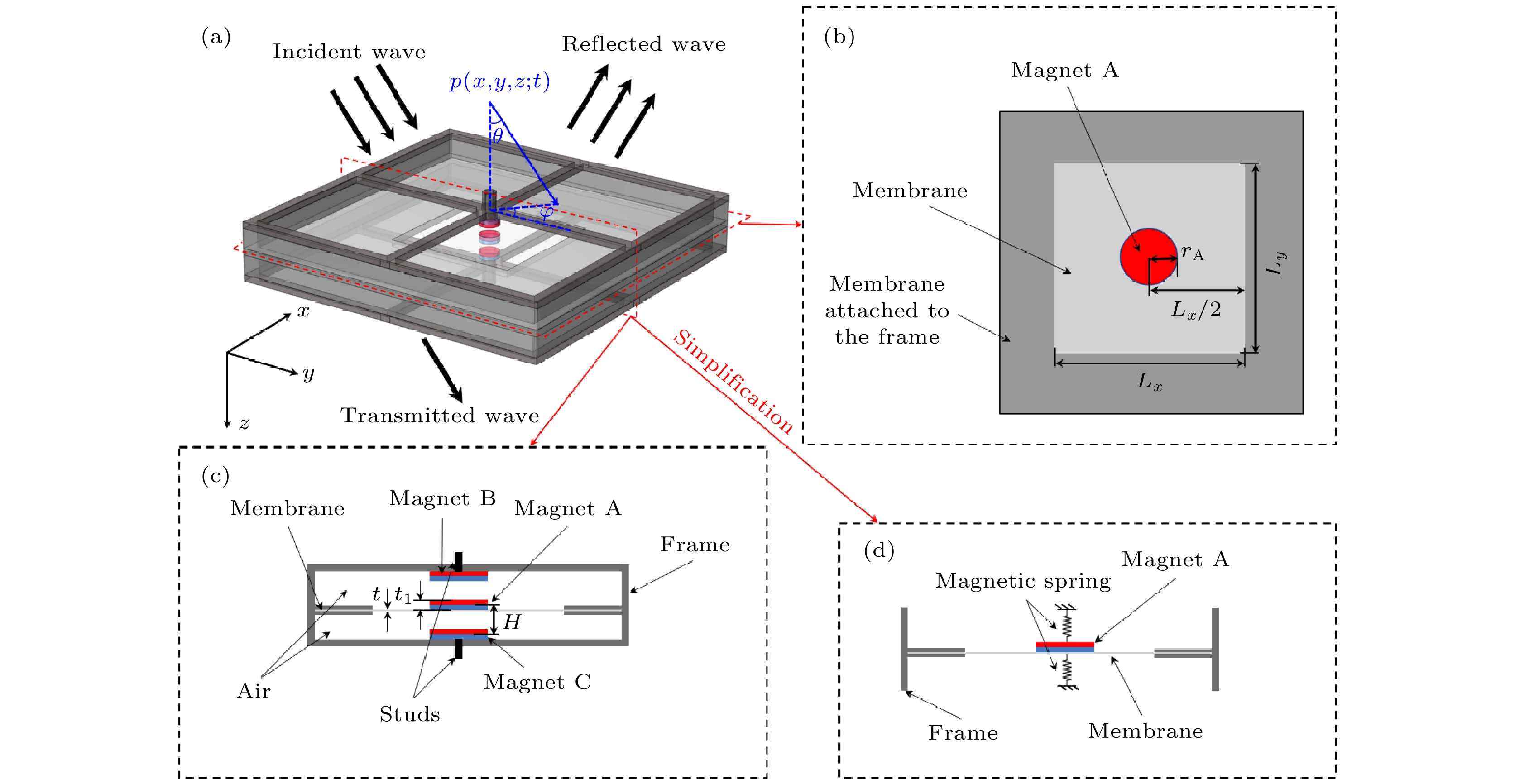
 下载:
下载:


